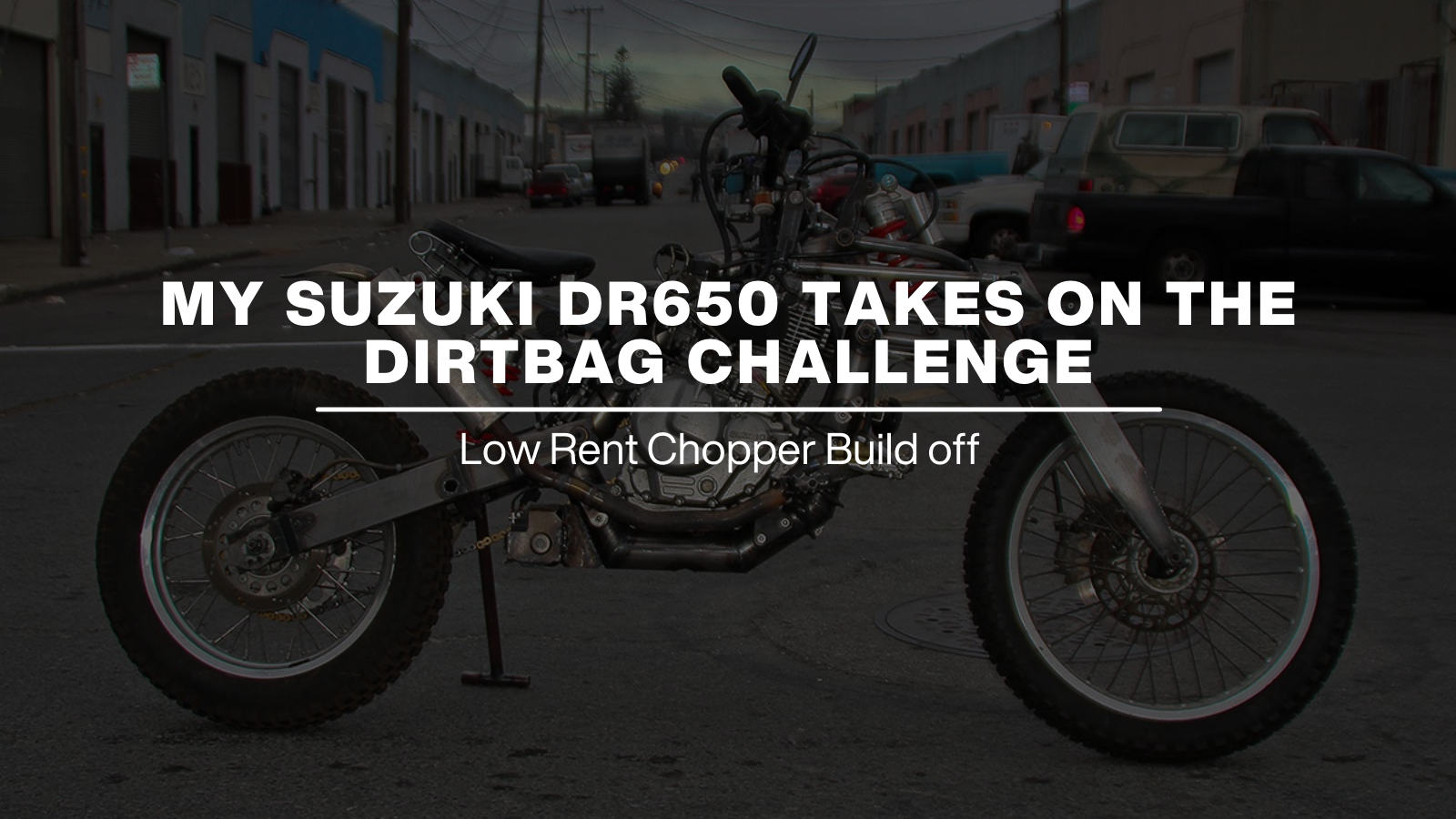...Or, how I turned a crappy old motorcycle into a cool-looking crappy old motorcycle.
by Gabe Ets-Hokin
Close your eyes and picture the perfect motorcycle. Is it a murdered-out chopper? An ADV bike with sleek, locking luggage and a fairing ensuring total comfort atop a 200-hp motor? Or a retro-styled cafe racer with modern reliability? Show me 100 motorcycle enthusiasts, and I'll show you 100 different “perfect” motorcycles...and 100 people resigned to never having them.
Sadly, most riders never customize their bikes to reach that goal of perfection. They're usually happy farkling their ride up a bit, bolting on a noisy (oops, sorry, I meant “sonorous”) pipe or maybe a new rear shock. But what if you want to do more?
Much more?
San Francisco Bay Area motorcyclists who want to build their dream bikes on a budget have turned to the Dirtbag Challenge for inspiration.

Dirtbag Challenge Founder Poll Brown smoking what is probably a cigarette. Photo: TK
Started in the early 2000s, the Dirtbag Challenge was an idea founder Poll Brown came up with while hanging with his rider friends. They were tired of watching chopper builders on reality TV, “cheesy, high-buck customs” for wealthy folk who likely didn’t do much riding. If any.
“Oi!” Poll (probably) said, “we should have a chopper-building contest where you can’t spend more than $1000, have to finish in 30 days…and no Harleys!”
Does Poll hate Harleys? Not at all – in fact, he owns two. He only worried that Harley-Davidsons, with their iconic looks and sounds, would lead to a Harley-only contest. His riding pals egged him on, and the first Dirtbag Challenge was on.

2012 Dirtbag Challenge entry. Photo: Bob Stokstad Photo
As word of the event spread, curious onlookers started showing up to watch the awards ceremony, which turned into a happening complete with all the “Bs:” Beer, BBQ, Bands and Babes, which of course led to Burnouts and Bandages. All the noise, smoke and drunken ribaldry was confined to a particularly grungy and un-gentrified part of San Francisco, so the authorities never seemed to care, at least not until the event got too big to ignore. In recent years it’s been held in Oakland, where anything goes. (But anything goes does not apply to my hearing protection, even without wind noise, motorcycle earplugs are an important part of my motorcyle gear.)
A few years into the ride, Poll noticed the entries were getting more elaborate, sillier and less ride-able, so he added a riding component to the event. At first it was just 50 miles, but since then it has grown to a multi-day tour going several hundred miles or more, and for the last few years, Poll decided to allow a $2000 budget and two months build time. Inflation? Or just to mix things up? Who cares? For a procrastinator like me, it made the event seem doable.

Alan Lapp’s 2015 Dirtbag Entry. Yes, he built the frame, swingarm and front end, and yes, he rode it 60 miles. No, he did not enjoy it. The motor is now not-running in the author’s bike. Photo: Alan Lapp
But what would be my weapon of choice? Well, I always liked big Singles, and my favorite custom bikes to look at in the various bike-porn blogs like Bike Exif, Rides and Culture and Pipeburn were the 80s and 90s aircooled thumpers converted into street-trackers and scramblers. I told my riding/business/fixin' stuff partner Alan Lapp—also a skilled fabricator and ex-racer—about one of the bikes, and told him he should build something like it out of his basket-case 1999 Suzuki DR650.
Al bought it used from a local riding celebrity—his girlfriend had apparently drowned it in a stream, and when a big-end bearing failed, Al pulled the motor, rebuilt it and used it in his custom-framed (and bonkers) 2015 Dirtbag entry. He had other plans for his 2020 entry, so he just started assuming I was going to build something like that...and I was off to the (building) races. Without knowing I was.

The plan. Amazing what you can do with MS Paint, isn’t it? What’s that? It’s not?
Within a few weeks, I was fully aware of what was happening and on the Dirtbag train. The rule is you can't start building until the start is announced via Facebook, but that's where jailhouse law steps in. Does “building” include planning and finding parts? The consensus is who knows and apparently, who cares? Pol takes a very dim view of those he would doubtless label as “wankers” protesting cheating, so planning and parts-buying started several months prior.
The planning took a while, but slowly it came into focus. I would rebuild the motor (Al assembled his transmission incorrectly in the last rebuild, and the bike wouldn't shift out of 3rd gear) and then Al and I would chop off the stock subframe and make a new one. A Chinese-made eBay tuck-and-roll Brat seat and old chrome fender would make up the back end. The front suspension and rear shock would remain—Al had Racetech rebuild both—and I would locate a set of 17-inch wheels with hipster-approved semi-knob radials. The tank? After much discussion, the consensus was an old Yamaha TT500 unit would be just right. Basic ingredients settled on and procured, the work could begin as soon as the “go” issued from Pol's Facebook page.

Why, it’s almost ready to ride!
It's not central to the story, but disassembling and reassembling the motor was a big deal, at least for me. Luckily, the DR650 powerplant is about as simple as it gets, and even after having to pull the cases apart a second time to get the transmission working right, I was amazed how easy it was. Nothing takes the mystery out of how bikes work like taking one apart to the last little bolt.
Next was the chassis. After stripping down the frame and removing the swingarm, Al and I submitted the frame to that staple of bike-building porn, the angle grinder. Hacking off 15 pounds of purple subframe was satisfying, as was covering up the 90s-era purple hue with black appliance paint. Once modernized, we then made tabs, measured tube steel for the subframe and thanks to Al's skill and talent with various grinders, welders, bandsaws and other implements of destruction, we soon had a spectacular subframe, ready for the seat. After fitting mounts for the tank (we spent a lot of time stripping and de-Bondo-ing the fabulously light and hand-made 40-year-old aluminum gas tank) we were ready to get the motor, suspension and wheels into place.

Hey! We built a motorcycle out of a bunch of motorcycle parts! Al built that subframe with stuff he had lying around his shop in less than an afternoon.
It now looked like an actual motorcycle, not a bunch of parts taking up space in Al's back room. But it was just a skeleton, really. Like a living being, it needed its nerves, lungs and...um...whatever an exhaust system is analogous to. The electrics were challenging, to say the least. Chopping the subframe meant there was less space for electrical stuff, as much of it had to fit in a little quart-sized box Al made for under the seat. We packed it in pretty tight, including the feathery lithium-ion battery, and were able to (just) get the seat down on top of it. Do I need to bore you with how even though I touched every wire on the wiring diagram, I still screwed up the wiring?
Yes it's true. Three days before the Dirtbag started, my DR wasn't running like it should, and it spent another two precious days chilling on a streetcorner a block from my house. Somehow I got it back to Al's garage, where we (sort of) quickly found the issue—I had swapped the battery ground and starter relay grounds, and left some random 20-gauge black wire connector loose. It was running, and we turned to getting Al's project (a 12-foot-long unicycle trailer for his Suzuki V-Stom, if you want to be nosy) running.

Yes, we know the headlight needs to be higher or the fender needs to be lower. it needs a lot of things, trust me. It’s a process, man.
Around 1:00 am the morning of the event, after spending hours diagnosing other problems and tidying up various details, I headed to the Shell station a few blocks from Al's house to top off the cavernous 2.2-gallon fuel tank. Gassed up, I headed back, and rolled the impossibly loud bike (the can we put on is a beat-up mess, and it muffles as good as it looks) into his driveway. Hopping off, I saw a large puddle of oil developing under the left engine cover.
Waaaah-wah. Sad trombone. An old injury to the cover, under the oil-cooler-line mount, probably temporarily fixed with JB Weld or just a lot of gasket material, had popped open. Al got into business with the welder, and I drained the oil to try and clean the spot enough for welding, but it was no good. At 2:15 am the day of the event, I decided I had had enough—I didn't want to jeopardize Al's participation keeping him up all night.

The mostly stock motor (rejetted carb and high-compression piston) doesn’t have a lot of go, but the supersized front rotor from Warp9 Racing should deliver plenty of woah.
Consolation prize—I have a pretty cool bike (that doesn't leak but has some new issue that keeps it from running right, but we'll get it!) that's completely different from anything I've ever seen on the road. It's a torquey, stone-reliable (in theory) 40-horsepower motorcycle that weighs less than 330 pounds gassed up, with modern radial tires and a huge front disc. It's the ultimate Sunday-morning ride, but most importantly, it opened a door for me.
I'll never be intimidated again by having to make something out of metal for my bike, or be forced to pay $300 for some simple gee-gaw Al and I can make ourselves in an afternoon. It's another step on my way to total independence as a motorcyclist. Simply put, modding and designing and creating a whole new bike, one that people stop and ask, “Hey, what is that?” is incredibly satisfying.

As cool as this weird hybrid Kerker/RC Racing exhaust can is, it’s too small and needs to go. It’s about as subtle as a Marx Brothers routine.




Share:
SXSW Launch: The Story Behind EARPEACE
GETTING BACK ON THE MOTORCYCLE AFTER A LONG WINTER